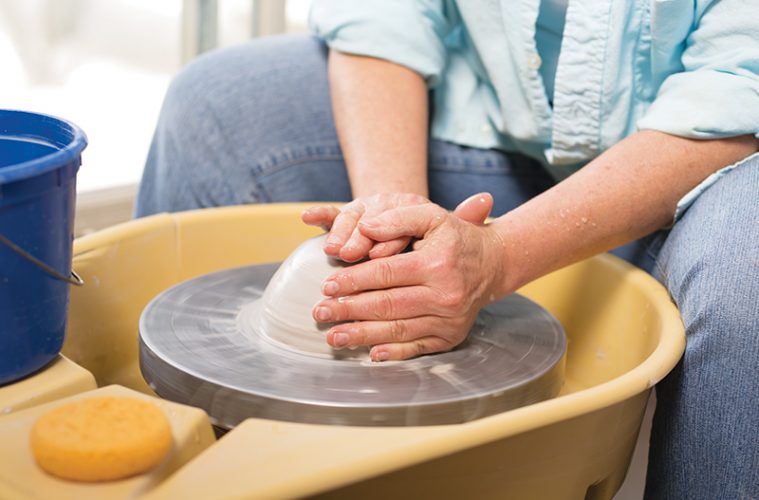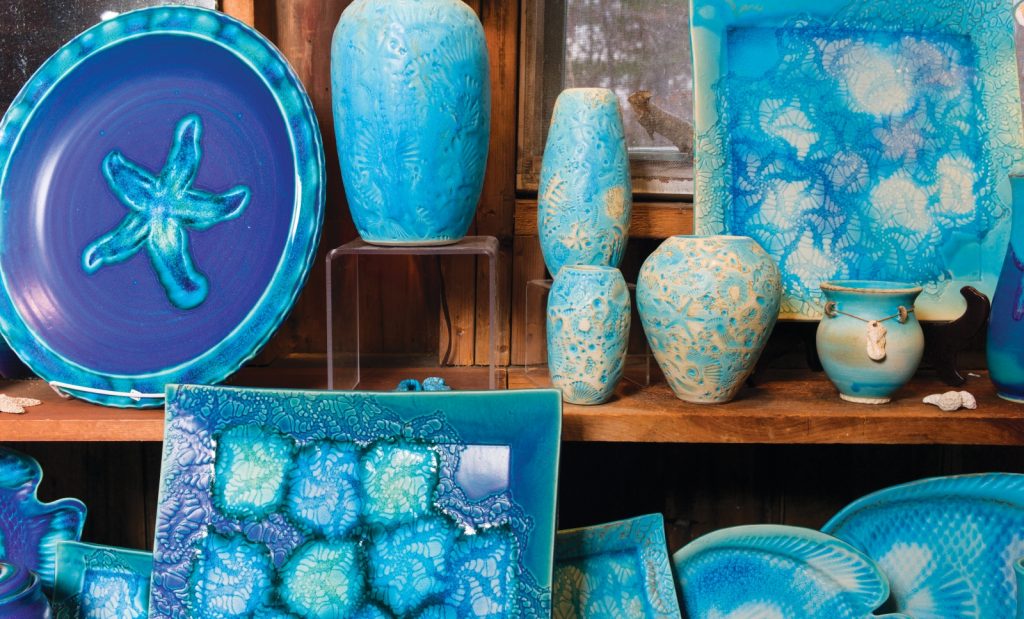As ceramicists know, clay has a life of its own. As much as an artist can consciously manipulate it, clay can exude an otherworldly spirit. Judy Bidwell of Gloucester has experienced the phenomenon in the serene Rockport studio of Cynthia Curtis, where Bidwell is a longtime student. When the clay starts to guide the artist, Bidwell says, Curtis’s extraordinary teaching skills come into play. One of Bidwell’s most memorable experiences was when Curtis blindfolded her and other students at the pottery wheel to produce a pot in one minute.
“I’ve always felt that clay has sort of a spirit of its own,” Bidwell says. “Sometimes clay ‘speaks’ to me. Cynthia helps me take the piece forward or back to the original concept in such an encouraging way. She’s a great guide.”
Bidwell’s most valuable life lesson from her classes is learning to let go. “It allows you to realize that you’re not totally in control of everything that happens,” Bidwell says. “You have to learn to let things be what they will be.”
Bidwell is one of more than 1,000 students who have taken classes at Cynthia Curtis Pottery, in a studio adjoining Curtis’s home. Located in a woodsy area near the quarries in Pigeon Cove, the studio shines with natural light and views. Her gallery is in a nearby barnlike structure.
For Curtis, whose own ceramic pieces sing of the ocean and its sea life, teaching fills a void. “It’s a special connection of heart, hands, and head,” she says. Curtis gets as much as she gives. “Working with clients is very therapeutic,” she says. Her students talk about over-coming stress and anxiety while they expand creativity, something Curtis has experienced many times. “When you’re sitting at a wheel or table, the clay takes all your attention,” she says. “It’s a hard skill to learn, so it’s very gratifying to learn to make a pot. Laughing and breathing are encouraged.”
|
With six eight-week class sessions a year, the studio buzzes with students of all ages, experience, and skill levels. Curtis has become known for her specialized group classes, teaching visually impaired children, women with brain injuries, and older students with Alzheimer’s disease. She also gives private lessons to individuals and families. “Families are fun,” she says. “You get to see the dynamics, parents doing something really fun with the kids.”
Students have access to eight wheels, two kinds of stoneware clay, and 35 different glazes that Curtis mixes. “I like color so much,” she says with a laugh. She names many of her glazes after fond memories. Cinnamon Bay, a Caribbean turquoise, is named after trips she took to St. John with her children. The gray-toned Oliver’s Blue is named after one of the special studio cats.
Curtis’s own ceramics tell lyrical stories of nature, especially ocean waters. A hand-built tray is imprinted with a piece of Curtis’s grandmother’s lace, with melted beach glass creating a sparkle effect. Lately she’s been experimenting with white glazes and brown clay. Sea Fossils, a new line, are fashioned from brown stoneware in an eggshell-toned glaze that is wiped to expose the clay, and decorated with starfish and shells.
Curtis, 56, started in ceramics in high school, but in college another part of her said it wasn’t feasible: “I had to have a real job.” She got her degree in special education and worked in retail management and marketing. After becoming a single mother 20 years ago, she enrolled in a class in Ipswich and her artistic fate was sealed. “I knew I wanted to make pots,” she says. “The question was, how could I make pottery and take care of my children?” She began teaching in 1994, which was the start of a fulfilling side venture: community building.
Bidwell notes that when Curtis built her studio, there was no place in the area to take pottery classes. “I’ve noticed that the ceramics art community on Cape Ann has grown,” she says. “I would say Cynthia is responsible for growing a large ceramics community.” Two years ago, two students and a teacher created the Cape Ann Ceramics Festival, which draws potters from far away and from the local community. Many credit Curtis with this new cultural identity.
For Curtis, it’s about giving and receiving. “There have been a lot of friendships that have started here, and so much community has been built,” she says. “I’m so grateful for that.” cynthiacurtispottery.com


 Photo by Jared Charney
Photo by Jared Charney